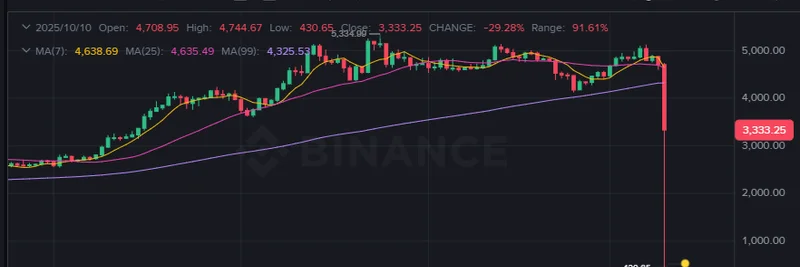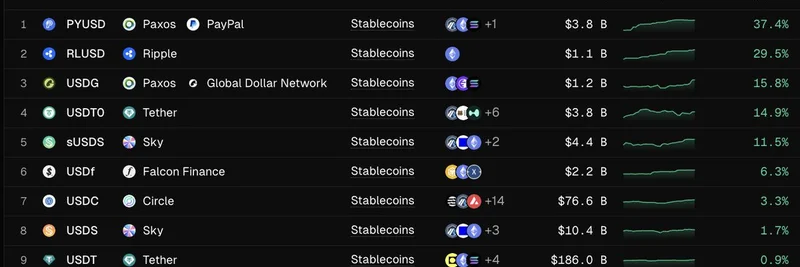If you've been keeping an eye on the wild world of meme tokens, you probably caught wind of the dramatic dip in MA7I that had everyone buzzing. A recent post on X by @PixOnChain captured the moment perfectly, showing a Binance chart where the price plummeted from highs around $4,700 to a low of about $430 before bouncing back to $3,333 – a whopping 29% drop in a short span. But as the poster pointed out, "this dip presented so many opportunities, you just have to know where to look." And they're spot on, especially when it comes to arbitrage plays between centralized exchanges (CEX) like Binance and decentralized exchanges (DEX) on chains like Solana.
What Happened with MA7I?
MA7I, a rising meme token in the Solana ecosystem, experienced what looked like a flash crash on October 10, 2025. The chart shared in the original tweet illustrates a steep decline, likely triggered by market volatility, liquidations, or even a temporary glitch – as one reply noted, it "seemed like a glitch for half a minute." But in the fast-paced crypto space, these moments aren't just setbacks; they're goldmines for quick-thinking traders.
Replies to the tweet echoed this sentiment. One user mentioned snagging AVAX at $8 during the chaos, only to see it rebound to $22. Others highlighted "juicy arbs" involving tokens like Trump and various wrapped versions of SOL. It's a reminder that in meme token land, where hype and FOMO drive prices, dips can create mispricings that smart players exploit.
Understanding Arbitrage in Crypto: CEX vs. DEX
For those new to the game, arbitrage – or "arb" – is basically buying an asset cheap in one place and selling it higher elsewhere, pocketing the difference. In crypto, this often happens between CEXs (think Binance, Coinbase) and DEXs (like Jupiter or Raydium on Solana). CEXs are centralized platforms with custodians handling your funds, offering high liquidity and fast trades but sometimes slower price adjustments during volatility. DEXs, on the other hand, are peer-to-peer, running on smart contracts, which can lead to quicker price swings but also slippage if liquidity is low.
During the MA7I dip, discrepancies popped up because CEXs and DEXs don't always sync perfectly. High traffic or network congestion can cause prices to lag, creating arb windows that last seconds or minutes. As @PixOnChain advised, "still a ton of arb between cex/dex btw, A TON (check different wrapped SOL etc)."
Spotlight on Wrapped SOL: A Prime Arb Target
Wrapped SOL refers to tokenized versions of Solana's native SOL coin, often used in DeFi for staking or lending. Popular variants include:
- bSOL (BlazeStake SOL): A liquid staking token from BlazeStake.
- mSOL (Marinade SOL): From Marinade Finance, offering staking rewards.
- jSOL (Jito SOL): Provided by Jito, focusing on MEV (maximal extractable value) rewards.
These wrapped assets can trade at slight premiums or discounts to native SOL, especially during market stress. In volatile times like the MA7I dip, prices on DEXs might drop faster than on CEXs due to panic selling, or vice versa. Traders could buy undervalued wrapped SOL on a DEX and sell on a CEX, or arbitrage between different wrappers if one lags.
One reply mentioned arbs with "bnsol" (likely a typo for bnSOL or similar) and other tokens. It's all about monitoring tools like DEX aggregators (e.g., Jupiter) or arb bots to spot these gaps. But remember, this isn't risk-free – gas fees, slippage, and timing can eat into profits.
Lessons from the Replies: Community Insights
The thread's replies add color to the story. Some folks laughed it off with "LOL" or advised to "just buy dips on your favorite tokens and go to sleep." Others warned about volatility: "market is so volatile, wouldn't recommend doing this rn tbh." It's a mix of optimism and caution that's typical in meme token communities. One user even quipped about seeing "discrepancies" instead of dips – a mindset shift that turns fear into opportunity.
How to Get in on the Action Safely
If you're inspired to hunt for similar opportunities, start small. Use platforms like Binance for CEX trades and Jupiter for DEX swaps. Tools like Dexscreener or Birdeye can help track real-time prices across venues. Always DYOR (do your own research), and consider the risks – meme tokens like MA7I are speculative and can rug or pump unpredictably.
In the end, events like this MA7I dip show why meme tokens remain exciting: they're not just about memes; they're about real-time market dynamics that reward the vigilant. Stay tuned to Meme Insider for more breakdowns on the latest in blockchain volatility and how to navigate it. What's your take on arb plays – hit or miss? Drop your thoughts below!


